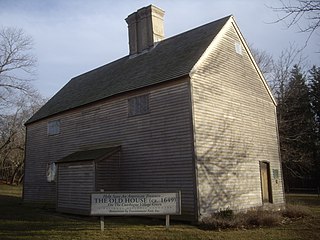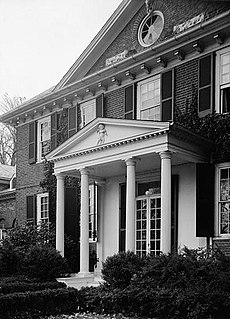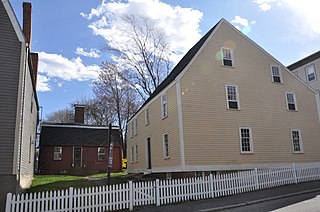
Thomas Sim Lee was an American planter and statesman of Frederick County, Maryland. Although not a signatory to the Declaration of Independence, the Articles of Confederation or the US Constitution, he was an important participant in the process of their creation. Thomas Sim Lee was the second State Governor of Maryland, serving twice, from 1779 to 1783 and again from 1792 to 1794. Thomas Sim Lee also served as a delegate of Maryland in the Congress of the Confederation in 1783 and was a member of the House of Delegates in 1787. He worked closely with many of the Founding fathers and himself played an important part in the birth of his state and the nation.

Maryland Route 223 is a state highway in the U.S. state of Maryland. The state highway runs 12.65 miles (20.36 km) from a dead end near Livingston Road in Piscataway north to Mellwood Road in Melwood. MD 223 passes through suburban areas of southern Prince George's County, including the community of Woodyard south of Andrews Air Force Base between MD 5 in Clinton and MD 4 in Melwood. The highway was constructed from Clinton to near Piscataway in the 1920s and early 1930s. MD 223 was extended west to Livingston Road in Piscataway and east to MD 4 in the mid-1950s. MD 223's interchanges with MD 4 and MD 5 were built in the mid-1960s and early 1990s, respectively.

The Belair Mansion, located in the historic Collington area and in Bowie, Maryland, United States, built in c. 1745, is the Georgian style plantation house of Provincial Governor of Maryland, Samuel Ogle. Later home to another Maryland governor, the mansion is listed on the National Register of Historic Places.

Darnall's Chance, also known as Buck House, Buck-Wardrop House, or James Wardrop House, is a historic home located at 14800 Governor Oden Bowie Drive, in Upper Marlboro, Prince George's County, Maryland, United States.

The Old House is a historic home on State Route 25 in Cutchogue in Suffolk County, New York. It is "notable as one of the most distinguished surviving examples of English domestic architecture in America."

The Abel and Mary Nicholson House is brick house built in 1722 in Elsinboro Township, New Jersey, United States. It is an excellent example of a Delaware Valley patterned brick building. The vitrified bricks form geometric designs and highlight the year of construction. The building has not been significantly altered since it was built and has been receiving grants to help preserve it. It was designated a National Historic Landmark for its architecture in 2000

Mount Pleasant is 2+1⁄2-story brick structure with a gambrel roof and is about two-thirds its original length. It is located near Upper Marlboro in Prince George's County, Maryland. Mount Pleasant was patented in 1697 to Richard Marsham, whose wife Anne was the daughter of Leonard Calvert, Governor of Maryland. Their grandson, Marsham Waring, inherited the home from his grandfather in 1713. His son, Richard Marsham Waring had a son, Richard Marsham Jr., born in 1733, who then inherited Mount Pleasant and Patented and Certified the tract of land dubbed "Mount Pleasant Enlarged" in 1760. On August 21, 1764, Richard Marsham Jr. sold the 451 ¾ acre tract of land to his brother John for £474.6s.9d. John later built the standing house in the years between 1764 and 1785. John died in 1813 and was buried at Mount Pleasant.

The Nathan and Mary (Polly) Johnson properties are a National Historic Landmark at 17–19 and 21 Seventh Street in New Bedford, Massachusetts. Originally the building consisted of two structures, one dating to the 1820s and an 1857 house joined with the older one shortly after construction. They have since been restored and now house the New Bedford Historical Society. The two properties are significant for their association with leading members of the abolitionist movement in Massachusetts, and as the only surviving residence in New Bedford of Frederick Douglass. Nathan and Polly Johnson were free African-Americans who are known to have sheltered escaped slaves using the Underground Railroad from 1822 on. Both were also successful in local business; Nathan as a caterer and Polly as a confectioner.

Tulip Hill is a plantation house located about one mile from Galesville in Anne Arundel County in the Province of Maryland. Built between 1755 and 1756, it is a particularly fine example of an early Georgian mansion, and was designated a National Historic Landmark in 1970 for its architecture.

His Lordship's Kindness, also known as Poplar Hill, is a historic plantation estate on Woodyard Road east of Clinton, Maryland. It was built in the 1780s for Prince George's County planter Robert Darnall. The five-part Georgian mansion retains a number of subsidiary buildings including a slave's hospital and a dovecote. The property is now operated as a museum by a local nonprofit preservation group. It was designated a National Historic Landmark in 1970.

The Gedney and Cox Houses are historic houses at 21 High Street in Salem, Massachusetts. The earliest part of the Gedney House was built c. 1665, and the houses were added to the National Register of Historic Places in 1974. They are owned by Historic New England, which offers limited tours.

St. Ignatius Roman Catholic Church is a historic Roman Catholic church located at St. Inigoes, St. Mary's County, Maryland. The church and its adjacent burial ground are situated on about two acres of land that are enclosed within a late 19th-century iron fence. The church was constructed between 1785 and 1787, with the sacristy added in 1817. The church walls are 21 inches thick, of brick laid in Flemish bond. Atop the roof is a small wooden belfry that in 1933 replaced a larger one in this same location.

St. Thomas Manor (1741) is a historic home and Catholic church complex located near Port Tobacco, Charles County, Maryland. Known as St. Ignatius Church and Cemetery, the manor house complex is the oldest continuously occupied Jesuit residence in the world. The mission settlement of Chapel Point was established in 1641 by Father Andrew White, S.J., an English Jesuit missionary. Father White administered to the Potapoco Native Americans, some of whom he converted to Catholicism. Established in 1662, this is the oldest continuously active Roman Catholic parish in the American Thirteen Colonies. With the consecration in 1794 of Bishop John Carroll, St. Thomas became the first Roman Catholic see in the United States.

Brooklandwood, or Brookland Wood, is a historic home located in Brooklandville, Baltimore County, Maryland. Its grounds became developed for the St. Paul's School for Boys.

Raspberry Plain is a historic property and former plantation in Loudoun County, Virginia, near Leesburg. Raspberry Plain became one of the principal Mason family estates of Northern Virginia, and was rebuilt in the early 20th century. It currently operates as an event site, hosting weddings and other special events year round.

Colonel Henry Darnall was a planter, military officer and politician in colonial Maryland. Darnall served as the Proprietary Agent in the colony for Lord Baltimore; he also briefly served as Deputy Governor of Maryland. During the Protestant Revolution of 1689, his proprietarial army was defeated by the Protestant army of John Coode, and he was stripped of his numerous colonial offices as a result. Darnall died in 1711, leaving the bulk of his substantial estates to his son, Henry Darnall II.

The Matthew Jones House is a historic plantation house located on Fort Eustis in Newport News, Virginia. The house sits on a hill toward the northern end of Mulberry Island, overlooking the James River. It was built ca. 1725 as a one-and-a-half-story frame dwelling with brick chimneys and later underwent two major renovations. During the first renovation, in 1730, the walls were bricked in and a shed room and porch tower were added. During the second, in 1893, the house was raised to a full two stories. In 1918 the house and its surrounding land were acquired by the U.S. government for the establishment of an army post. By the late twentieth century, the Matthew Jones House had fallen into grave disrepair. In 1993 it was preserved and rehabilitated by the National Park Service in cooperation with the U.S. Army Corps of Engineers. Today it serves as an architectural museum.

Mary Digges Lee was an American patriot. She was called the "First Lady of Maryland" and later inducted into the Maryland Women's Hall of Fame.
Henry Darnall II (1682-1759) was a wealthy Roman Catholic planter in Colonial Maryland. He was the son of the politician and planter Henry Darnall, who was the Proprietary Agent of Charles Calvert, 3rd Baron Baltimore, and served for a time as Deputy Governor of the Province. During the Protestant Revolution of 1689, Henry Darnall I's proprietarial army was defeated by the Puritan army of Colonel John Coode, and he was stripped of his numerous colonial offices. After his father's death, Henry Darnall II did not enjoy political power in Maryland, but he remained wealthy thanks to his family's extensive estates. He married twice, fathering many children. His eldest son Henry Darnall III (c1702-c1783) inherited the bulk of what remained of his estates, and one of his grandchildren, Daniel Carroll, would become one of the Founding Fathers of the United States. A small portion of Darnall's former property, now called Darnall's Chance, can still be visited today.

Eleanor Darnall Carroll (1703-1796), was a wealthy heiress in colonial Maryland. She was the wife of Daniel Carroll, a politician and wealthy planter. Their son Daniel Carroll became one of the Founding Fathers of the United States; their son John Carroll became the Archbishop of Baltimore and founder of Georgetown University.























